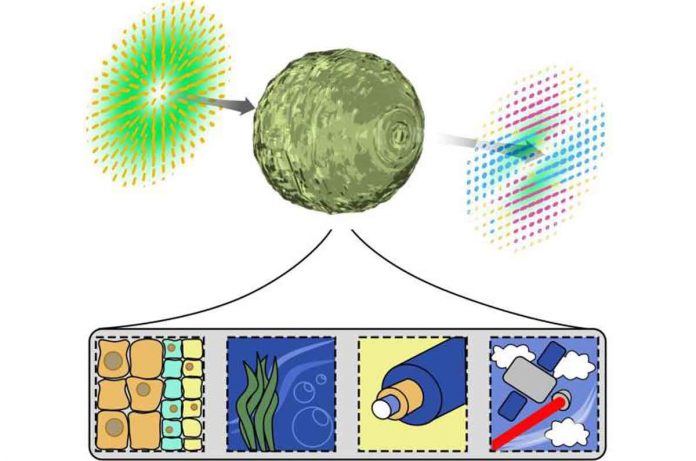A team led by researchers at the University of the Witwatersrand in Johannesburg, South Africa, with collaborators from the University of Pretoria (South Africa), Mexico, and Scotland, has made a new discovery about how light behaves in complex media, which distorts light significantly. They demonstrated that “distortion” is a matter of perspective by laying out a simple rule that applies to all light and a wide range of media, including underwater, optical fibre, atmospheric transmission, and even living biological samples.
Their novel quantum approach to the problem resolves a long-standing debate about whether some forms of light are robust or not, correcting some community misconceptions. Importantly, the work outlines that all light has an unchanging property, which holds the key to unravelling the rest of the perceived distortion. To validate the discovery, the team demonstrated robust transport through otherwise highly distorted systems, with the result used for error-free communication over noisy channels.
The study, led by Professor Andrew Forbes of Wits University’s School of Physics, was published online today in Nature Photonics. The team explains the simple rules that govern complex light propagation in complex media in their paper. For starters, they discover that all such media can be treated the same way, and that the analysis is independent of the type of light used. Previously, each medium and light beam configuration was treated as a separate case; this is no longer the case; the new general theory encompasses everything.
Second, they demonstrate that, despite the distortion, a property of light—its “vectorness”—remains constant and invariant to the medium. This is always true and was previously overlooked.It holds the key to utilising light even in less-than-ideal conditions.
When light passes through an imperfect medium, such as the atmosphere, it becomes distorted. For example, the shimmering mirage effect near hot roads or the twinkling of stars are both examples of distorted light caused by atmospheric turbulence. Light can also be deliberately distorted, as in fun fair mirrors that make you appear taller, thinner, or rounder. We all understand that the distortion is simply a matter of perspective in this case—a quick glance in the mirror reveals the truth—but is this also true in other distorting systems? Is there a way to look at the light to remove the distortion?The Wits-led team demonstrates that, while some properties are never distorted, others can be unravelled with a shift in perspective.
The question is how to comprehend what happens to light, how it is distorted, and how to discover a new perspective. To answer these questions, the team used vectorial light, the most general type of light. Light has an electric field that can change direction across the field, pointing upwards, downwards, left, right, and so on. The “vectorness” of a light refers to how mixed up the direction of its electric field is. In other words, it is a measure of how similar the directions of a light’s electric fields are at different locations: if they are the same everywhere (homogenous), the value is 0, and if they are different everywhere (inhomogeneous), the value is 1.Even if the pattern of the electric field changes, this vectorial homogeneity remains constant. The explanation is hidden in quantum entangled states, which appear to have little in common with optical distortions. The new discovery was made possible by applying quantum-world tools to optical distortions.
“We discovered that the vectorness of light is the single attribute of light that does not change when it passes through any complex medium,” says Professor Andrew Forbes of the Wits School of Physics. “This means we have something unique that can be used when communicating or sensing with light.”
“This is a specific aspect of the light pattern—how the polarisation pattern looks,” Forbes explains. “The term “polarisation” simply refers to the direction of the electric field that makes up light. The pattern is distorted as well, but its intrinsic nature (whether homogeneous or inhomogeneous) is not.”
The team’s approach enables researchers to identify how to correct any distortions in the media without using any light. To put it another way, there is no loss.
“We demonstrate that, despite the fact that the light is highly distorted, the distortion is simply a matter of perspective. Light can be viewed in such a way that its original ‘undistorted’ properties are restored. It’s amazing how complex light in complex media can be universally understood by following very simple rules.”
For example, by simply changing how a measurement is made, any communication over a highly distorted medium can be rendered “distortion free.” This was demonstrated experimentally by the team using a variety of systems, including turbulence, liquid, and optical fibre.

